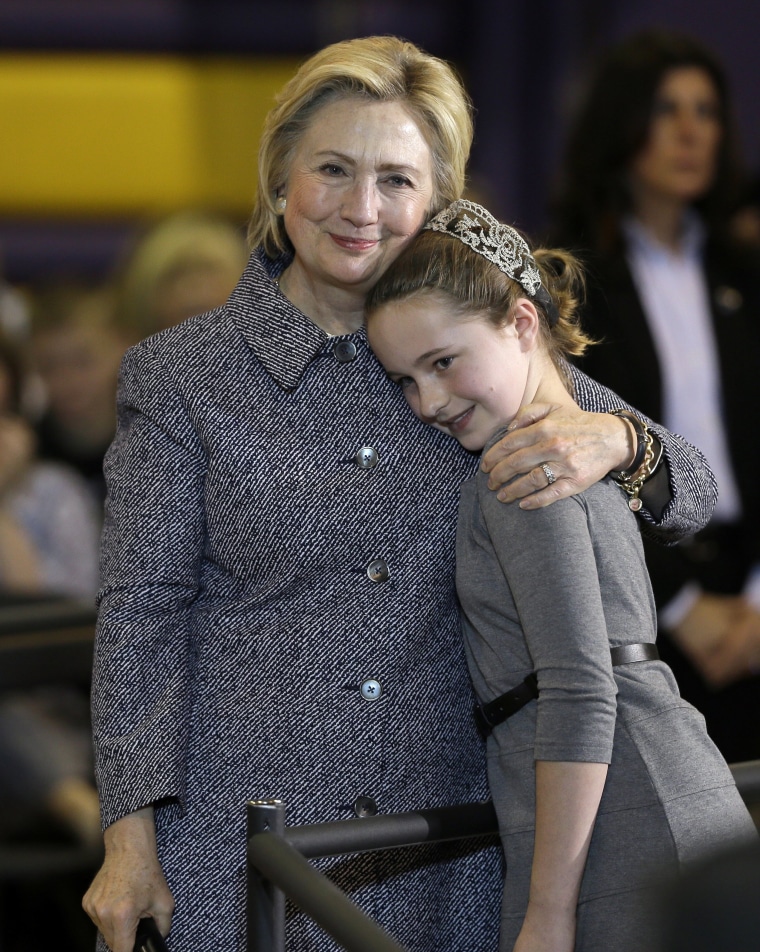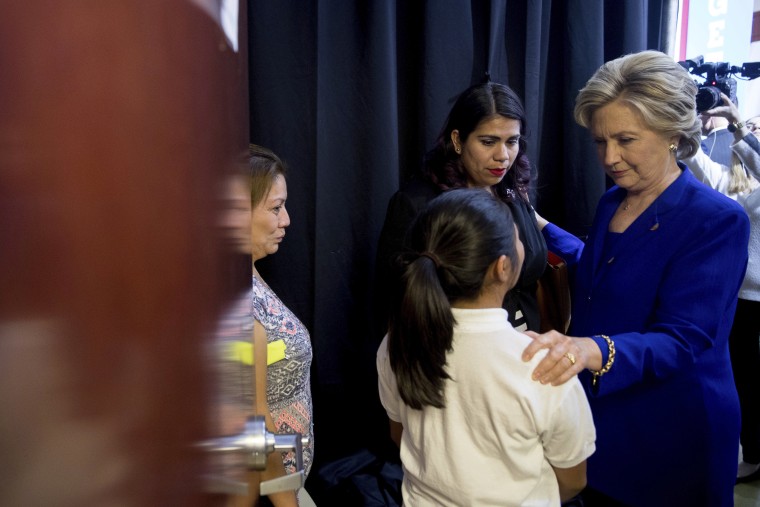She came close to the glass ceiling, but proved unable to break it. Unfortunately for the candidate hoping to make history as our first woman president, broad Hispanic support was not enough to help Hillary Clinton win the White House.
By early Wednesday morning, it was the end of the political road for Clinton, who triumphed over Bernie Sanders during the primaries and only to lose to Donald Trump in the general election.
For many Latinos, Clinton’s defeat was a stunning and deeply personal loss.
“As I wake up today with a broken heart I feel the need to be positive,” actress and Clinton supporter Eva Longoria wrote on Instagram. “As I read and understand everyone's pain it makes me want to pray for everyone else's broken heart who believed in Hillary and her vision.” Longoria wished Trump well, for the sake of our “beautiful country.”
So as the reality of a Trump presidency sinks in, here’s a look back at six times Latinos figured into Clinton’s historic campaign.
1. Amanda Renteria signs on as Clinton national political director (March 2015)
Renteria, 41, was the highest-ranking Latina staffer in the Clinton campaign. She was already on-board when Clinton announced her candidacy; Renteria said on MSNBC that, "This is really about meeting people where they are. When you look at her first video, it was about other people. It's always about other people.”
This was not the first time a Latina had played a leading role in a Clinton campaign. In 2008, Patti Solis Doyle served as her campaign manager. Solis Doyle was the first Latina to lead a presidential campaign, until Clinton suffered an embarrassing defeat in Iowa.
RELATED: Clinton Campaign's Amanda Renteria: How They're Building Latino Support
The daughter of a former farm worker, Renteria is from California’s Central Valley. After attending Stanford, she returned home to run for Congress in 2014. Although she lost, her bid for office showed her that Democrats could not take the Latino vote for granted.
"It means a lot to us in the Latino community to have someone like Amanda at the table making decisions,” Rep. Ben Ray Lujan (D-N.M.) told the Los Angeles Times, “and making sure the community is at the table."
2. Clinton campaign hires Lorella Praeli (May 2015)
Last year, Clinton met with a group of DREAMers, undocumented youth brought here by their parents as children, at a Las Vegas roundtable. They were prepared to challenge her immigration positions with tough questions. Clinton won them over by promising to go further than President Obama on immigration, including taking broader executive action if necessary. As if to show that the campaign was serious about this commitment, weeks later they hired Lorella Praeli, a prominent activist previously affiliated with United We Dream, to head its Latino outreach effort.
Praeli, who had been undocumented for almost 13 years, went on to serve as a surrogate for the campaign and as a liaison to Latino communities nationwide. She became a citizen in December 2015, at a ceremony attended by President Obama.
In August, Praeli helped the campaign launch Mi Sueño, Tu Voto (My Dream. Your Vote), a program aimed at organizing DREAMers to register voters.
DREAMers like Praeli becoming involved in political campaigns seems like a natural progression to Bernadette Sanchez, professor of psychology at DePaul University. Sanchez told NBC News that it is still challenging for DREAMers to venture into the public eye. They may face pressure, for example, from other family members not to do so.
RELATED: Hillary Clinton Hires DREAMer Lorella Praelli As Latino Outreach Director
Many DREAMers feel isolated and alienated before ‘coming out’ as undocumented, Sanchez explained. “But once they do come out, they often find a whole network of others like them.” Praeli is a very visible example of these young activists. “They feel a strong sense of responsibility to others who don’t have DACA, or who don’t have any voice at all. They feel an obligation to help their communities.”
3. “Hillary Clinton is just like your abuela” (December 22, 2015)
Hillary Clinton and your abuela (grandmother). What could possibly go wrong? In a word, everything. A Latina staffer at the Clinton campaign probably had good intentions when she wrote a blog post enumerating seven ways Clinton was just like your abuela, such as “she reads to you at bedtime” and “she isn’t afraid to talk about the importance of respeto.”

The backlash was swift. Latino commentators saw this outreach effort as offensive “Hispandering,” and the social media blowback caught the attention of outlets from Salon to The New York Times. The hashtag “#NotMyAbuela” trended on Twitter; one typical response was “My abuela does not advocate for the deportation of refugee and unaccompanied children,” a reference to Clinton’s earlier positions on the plight of Central American child migrants.
In response, the Clinton campaign changed the blog post title to “7 things Hillary Clinton has in common with your abuela,” and offered up a clarification to NBC News. It marked an inauspicious start to Clinton’s Latino outreach.
Julio Ricardo Varela, Political Director of the Futuro Media Group, explained that the blog post generated a negative reaction because it was seen as inauthentic. “The reaction was very organic, visceral, and raw,” he said. “Latino Millennials are sharp and media-savvy. The abuela post clearly wasn’t the right strategy because it was widely seen as manufactured.”
In hindsight, Varela sees the abuela controversy as a lesson to the Clinton campaign. “People were saying, ‘Don't speak at me, speak to me.” It speaks to the question of how to communicate to a growing demographic,” he said.
RELATED: Hillary Clinton and The 'Abuela' Factor
“It really caught the Clinton campaign by surprise. But they seemed to learn from it, and become better attuned to Latinos, although that became easier because of Trump.”
4. Rosario Dawson takes on Dolores Huerta (March 24, 2016)
During the primaries, Latina actress Dawson wrote an “open letter” in The Huffington Post to Huerta, the civil rights icon who she played in the 2014 movie, Cesar Chavez. In the article, Dawson, a Sanders supporter, took issue with what she called Huerta’s misrepresentation of Sanders’ record. Dawson also accused Huerta of spreading the false story that Sanders supporters had chanted, “English only” at a Nevada rally.
To onlookers, the public spat between two generations of activists seemed personal. “Rosario Dawson, how dare you lecture Dolores Huerta?” ran the headline of a column in The Guardian.
Rodolfo F. Acuña, founder of the Chicana/o Studies program at California State University Northridge, feels that Dawson had the right to vent her feelings. “I think she was taking a stand for Bernie Sanders,” he said, “but in the media it was framed as her being against Dolores Huerta. It was put in terms of a Puerto Rican versus a Mexican.” If Dawson erred, he believes, it was to put the spotlight on Huerta rather on than on Hillary Clinton.
Acuña thinks the women’s divergent views were blown out of proportion in the media. “Meanwhile, when was the last time the violence in Honduras was mentioned in this election? Gentrification in our communities? The war on drugs? Personally, I am very disappointed with this entire election.”
By April, both Huerta and Dawson were saying that their friendship was intact.
Christina Bejarano, associate professor of political science at the University of Kansas, saw this episode as an example of the “vast diversity” among the Latino community.
RELATED: Dolores vs. Rosario And The Fight for Young Latino Votes
This was more apparent during the primaries, she pointed out. “We are likely to see Latino diversity became more apparent again when they are not in coalition against a common enemy,” Bejarano wrote in an email. “Then there will be more dialogue among Latinos across the considerable differences in national origin, generation, religion, and sexuality.”
5. Karla Ortiz and Astrid Silva address the DNC (July 25, 2016)
When she met Clinton earlier in the year, Ortiz, age 11, expressed fear that her undocumented parents would be deported. Their meeting was captured on camera and subsequently made into a TV ad. “I’m going to do everything I can so you don’t have to be scared,” Clinton told her.
Months later, Ortiz recounted this moment to the crowd on the first night of the Democratic National Convention, with her mother standing beside her. The Huffington Post called her remarks “the one speech that met with near-unanimous approval.”
Astrid Silva, 28, took the stage after Ortiz to share her story of growing up undocumented. Silva is a DREAMer whose letters to Senate Majority Leader Harry Reid helped inspire his support for immigration reform.
Frank Sharry of the pro-immigration group America’s Voice told NBC News that Ortiz and Silva each made “strong emotional impact” with their respective speeches.
RELATED: Clinton Ad With Latina Girl Hits Emotional Issue Of Deportations
“There was a DREAMer on stage in 2012 (Benita Velez) at the DNC. This time, it was significant that the Clinton campaign went further and presented a DREAMer and her mom,” Sharry said. “It seemed to symbolize that the Clinton candidacy and presidency intended go further than President Obama did on immigration reform.”
Sharry was impressed by the campaign giving these young women such a visible platform. “The immigration debate used to be about the undocumented,” he said. “Undocumented people were afraid to be part of it. Now instead being the object of debates, they are leading the movement.”
6. The revenge of Miss Universe (September 2016)
Near the close of the first presidential debate, Clinton reminded millions of viewers of Trump’s past humiliation of Miss Universe 1996. “He called this woman ‘Miss Piggy.’ Then he called her ‘Miss Housekeeping’ because she was Latina,” Clinton said.
After Trump stammered “Where did you find this?” three times, Clinton moved in for the kill.
“Her name is Alicia Machado,” Clinton declared. “And she has become a U.S. citizen. And you can bet, she is going to vote this December.” It was the moment of the night, because Clinton clearly got under Trump’s skin.
“It was a pre-programmed play, and he (Trump) took the bait,” said Gabriela Domenzain, former deputy campaign manager for Martin O’Malley. “This was the moment that everyone in the Clinton campaign was waiting for, because on the debate stage, candidates have many lines rehearsed.”
Machado quickly made a return to the public eye. “Who is Alicia Machado?” scores of reporters wanted to know, and soon the campaign had her everywhere, making appearances on The Today Show, The View and helping Clinton get out the Latino vote. Machado filmed an ad for the campaign as well.
RELATED: Former Miss Universe Gets Citizenship, Will Vote Against Trump
Looking ahead, Domenzain hopes that our next president is mindful of who and what helped them win the presidency. She sees the possibility of a new progressive coalition taking hold, including everyone from the Black Lives Matter movement to Latinos to Millennials to American Muslims.
“The next president with have to answer to the divisive national tone, and all of these wounds are deep and raw,” Domenzain said. “The healing will come from the bottom up, from the middle out, and it will be a grassroots effort.”

